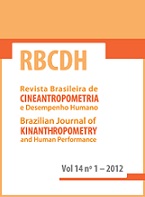Skeletal-muscle mass of São Paulo city elderly – SABE: Survey: Health, Well-being and Aging
DOI:
https://doi.org/10.1590/1980-0037.2012v14n1p1Abstract
The analysis of skeletal muscle mass (SM), either total (TSM) or appendicular (ASM) mass, in the elderly, is important, in order to monitor this component along aging, and these values are more associated with disability when adjusted for height, thus enabling the analysis of total (TSMI) and appendicular muscle mass indexes (ASMI). The purpose of this study was to present standard mean and percentile values of TSM, ASM, TSMI and ASMI, from elderly of São Paulo city, according to gender and age groups. The sample consisted of 1203 elderly, men and women, from the 2006 cohort of the SABE Study: Health, Well-being and Aging, held in São Paulo, Brazil. Variables TSM and ASM were identified by predictive equations, while the respective indexes, by the ratio between the values of SM and height to the squared (in kg.m-2). The mean values and standard deviation of TSM, of women and men, younger and older than 80 years old, were, in kg, 17.7±3.6, 14.4±3.2, 26.9±3.8 and 24.1±2.9, respectively, while the values for ASM were 14.4±2.1, 13.0±2.0, 21.0±2.8 and 19.4±2.3, respectively. When adjusted by height to the square, the values of TSMI were, in kg.m-2, 7.6±1.4, 6.3±1.2, 9.8±1.1 and 8.9±0.9, and the values of ASMI were 6.1±0.7, 5.7±0.7, 7.6±0.8 and 7.2±0.7, respectively. All the variables were correlated among themselves (r>0,84). Men and younger elderly presented higher values, with statistical significance, in relation to their peers, and the differences between age groups were higher among women.



